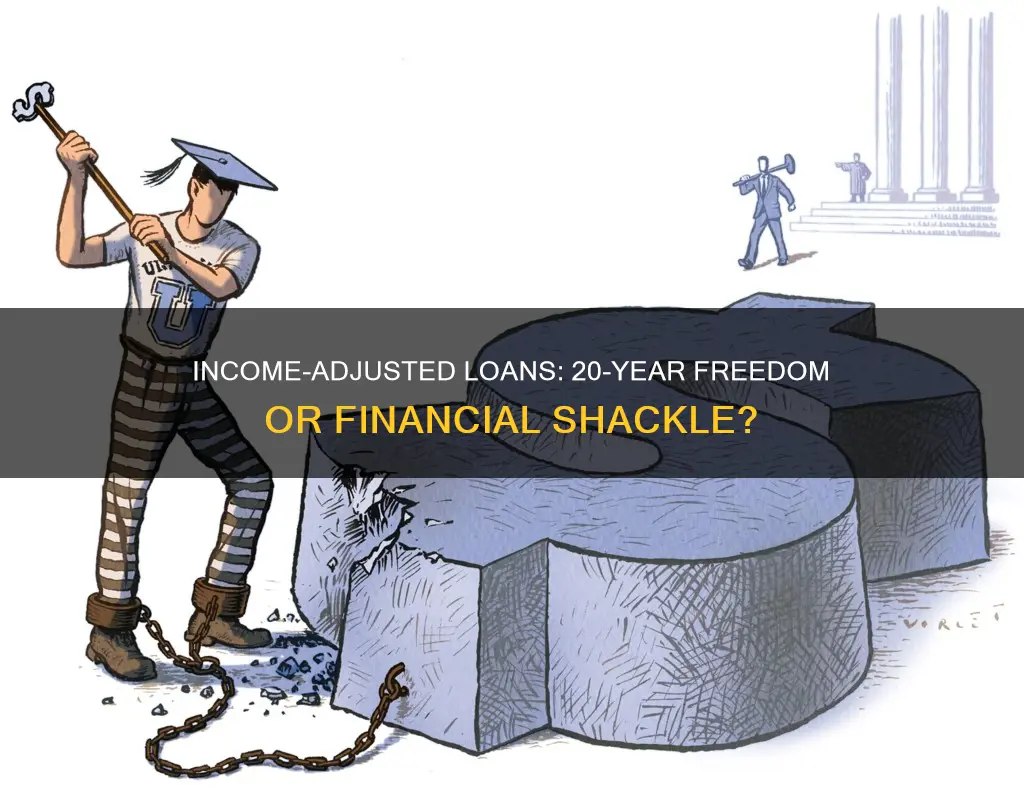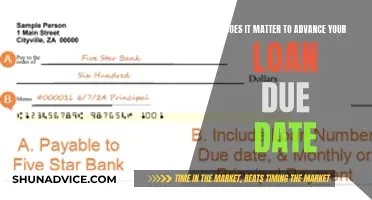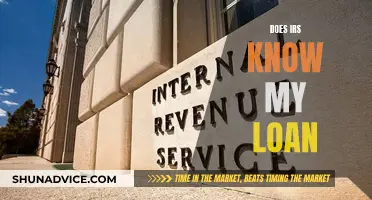
Student loans are a significant concern for many, with some individuals still dealing with them after 20 years. While federal student loans are never written off due to their age, there are various options for loan forgiveness, discharge, or cancellation. These include Public Service Loan Forgiveness, income-based repayment forgiveness, or total and permanent disability discharge. Income-driven repayment plans are a popular option for repayment and can make monthly payments more affordable. These plans can lead to loan forgiveness after 20 or 25 years, depending on the specific plan and the borrower's circumstances.
| Characteristics | Values |
|---|---|
| Loan Forgiveness Timeline | Federal student loans can be forgiven after 10 years through Public Service Loan Forgiveness (PSLF) or after 20-25 years under Income-Driven Repayment (IDR) plans. |
| Default Status and Credit Reports | Defaulted loans don't disappear after 7 years, but the default status may be removed from your credit report, though the debt remains. |
| Loan Discharge Options | Loans may be discharged in cases of death, permanent disability, or school fraud. |
| Private Loan Statute of Limitations | Private loans may have a statute of limitations, which limits legal action but doesn’t erase the debt. |
| Bankruptcy and Student Loans | Bankruptcy can discharge student loans, but it requires proving undue hardship, which is difficult to achieve. |
| Loan Forgiveness Programs | To access loan forgiveness programs or other options, you may need to get your loans out of default and into good standing. |
| Payment Calculation | Monthly payments for IDR plans are based on a borrower's income and family size. |
| Payment Percentage | Each of the IDR plans uses a different percentage of your discretionary income (ranging from 5% to 20%) and has different student loan forgiveness benefits (20 to 25 years). |
| Payment Strategies | Reducing your AGI is the most effective way to lower your federal student loan payment. Strategies include using "above-the-line" tax deductions, such as contributions to a pre-tax retirement plan. |
What You'll Learn
- Federal student loans can be forgiven after 10 years
- Income-Driven Repayment plans can be eligible for forgiveness after 20-25 years
- The Department of Education offers four Income-Driven Repayment plans
- Loan forgiveness can be achieved through Public Service Loan Forgiveness
- Reducing your AGI can lower your federal student loan payment

Federal student loans can be forgiven after 10 years
The Saving on a Valuable Education (SAVE) Plan is another option for federal student loan forgiveness after 10 years. This income-driven repayment (IDR) plan bases monthly payments on a borrower's income and family size.
It is important to note that federal student loans are never written off because they have grown old or expired. They will remain on credit reports until they are paid in full or qualify for forgiveness.
Honda's 84-Month Loans: Is It Worth It?
You may want to see also

Income-Driven Repayment plans can be eligible for forgiveness after 20-25 years
Income-driven repayment plans are a popular option for borrowers as they can make monthly payments more affordable. These plans are based on a borrower's income and family size, and they offer forgiveness of the loan balance at the end of the repayment period. The Department of Education currently offers four income-driven repayment plans:
- Pay As You Earn (PAYE): Payments are generally 10% of your discretionary income, but never more than the 10-year standard repayment plan amount. The remaining unpaid balance of loans is forgiven after 20 years.
- Income-Based Repayment (IBR): Depending on when the loan was first taken out, payments are generally 10% or 15% of the borrower's discretionary income, but never more than the 10-year standard repayment plan amount. The remaining unpaid balance of loans is forgiven after 20 or 25 years.
- Income-Contingent Repayment (ICR): Payments are 20% of your discretionary income or what you would pay on a repayment plan with a fixed payment over 12 years, adjusted according to your income. The remaining unpaid balance of loans is forgiven after 25 years.
- Saving on a Valuable Education (SAVE): Formerly known as Revised Pay As You Earn, this newly updated plan requires payments of 5% to 20% of a borrower's discretionary income. The remaining unpaid balance of loans is forgiven after 20 or 25 years.
It is important to note that the forgiveness of the loan balance after 20 or 25 years is treated as taxable income, so borrowers will have to pay income taxes on the amount discharged that year. Additionally, borrowers enrolled in income-driven repayment plans do not need to apply for forgiveness. The Department of Education and its contracted loan servicers are responsible for identifying borrowers who have made enough qualifying payments to receive forgiveness.
To lower the monthly payments on federal student loans, borrowers can consider strategies to reduce their adjusted gross income (AGI). This includes making contributions to a pre-tax retirement plan, such as a 401(k) or a traditional Individual Retirement Account (IRA).
Understanding Your Rights to Your Spouse's 401(k) Loan
You may want to see also

The Department of Education offers four Income-Driven Repayment plans
The Department of Education previously offered four Income-Driven Repayment (IDR) plans: Saving on a Valuable Education (SAVE), Income-Contingent Repayment (ICR), Income-Based Repayment (IBR), and Pay As You Earn (PAYE). However, as of February 2025, the Department of Education has removed the online application for these IDR plans, preventing borrowers from enrolling, recertifying, or adjusting their repayment terms through the federal website. This decision was made in response to a federal court injunction that blocked key aspects of the IDR program, including the SAVE plan.
Each of the four IDR plans offered by the Department of Education has unique features and benefits. Here is a more detailed overview of each plan:
- Saving on a Valuable Education (SAVE): Formerly known as Revised Pay As You Earn, this plan offers personalized monthly student loan payments based on the borrower's income and family size. It is considered the most affordable repayment plan by the Biden Administration. However, the SAVE plan has been the subject of legal disputes, with a federal court blocking its implementation and questioning the authority of the Secretary of Education to implement such a plan. As a result, borrowers enrolled in the SAVE plan have been in forbearance, and the Department of Education has removed the online application for new borrowers.
- Income-Contingent Repayment (ICR): Under ICR, payments are typically set at 20% of the borrower's discretionary income or adjusted to match a fixed payment plan over 12 years, depending on which amount is lower. After 25 years, any remaining unpaid balance on the loans is forgiven.
- Income-Based Repayment (IBR): IBR payments are generally set at 10% or 15% of the borrower's discretionary income, depending on when the loans were first taken out. The payments will never exceed the amount of a standard 10-year repayment plan. Similar to ICR, any remaining balance on the loans is forgiven after 20 or 25 years.
- Pay As You Earn (PAYE): PAYE plans typically require payments of 10% of the borrower's discretionary income, never exceeding the amount of a standard 10-year repayment plan. After 20 years of payments, the remaining unpaid balance on the loans is forgiven.
Hyundai Warranty: Loaner Coverage and Your Rights
You may want to see also

Loan forgiveness can be achieved through Public Service Loan Forgiveness
Income-driven repayment plans can be a popular option for borrowers looking to make their monthly payments more affordable. These plans are based on a borrower's income and family size and can offer repayment periods of up to 20 or 25 years. At the end of the repayment period, the remaining unpaid balance of the loans is forgiven.
PSLF is one of the most popular federal student loan forgiveness programs, but it is not the only one. Other paths to loan forgiveness include teacher loan forgiveness, total and permanent disability discharge, and income-driven repayment plans. Income-driven repayment plans can lead to forgiveness through the PSLF program, but they can also be a standalone path to forgiveness. Under these plans, the remaining loan balance can be forgiven after 20 or 25 years, depending on the amount owed and the type of debt.
Hospital Bills: Impacting Loan Decisions?
You may want to see also

Reducing your AGI can lower your federal student loan payment
Federal student loans can be forgiven after 20 years under Income-Driven Repayment (IDR) plans. Monthly payments under IDR plans are based on a borrower's income and family size. Specifically, the plans use a borrower's Adjusted Gross Income (AGI) as a starting point to determine their monthly payments. AGI is calculated as the total gross income minus "above-the-line" deductions.
Reducing your AGI can, therefore, lower your federal student loan payment. One way to reduce your AGI is by maximizing "above-the-line" deductions. For example, contributions to a pre-tax retirement plan, such as a 401(k) or a traditional Individual Retirement Account (IRA), can lower your AGI. Similarly, if you have a high-deductible health plan (HDHP), you can make tax-deductible contributions to a Health Savings Account (HSA) for future medical expenses, which will also reduce your AGI.
Another strategy for married couples is to file separate tax returns. If you owe federal student loans but your spouse does not, filing jointly may result in a higher AGI, which could increase your student loan payments. By filing separately, your spouse's income will not be included in your AGI, potentially resulting in lower loan payments. However, it is important to consider the overall tax implications of filing separately, as it may result in higher taxes. Consulting with a tax professional or accountant can help determine the best course of action.
Additionally, private and federal student loan borrowers can deduct up to $2,500 of paid interest on their qualified education loans. This deduction can lower your taxable income and, consequently, your tax liability. However, this student loan interest deduction has modified AGI limits. If your modified AGI exceeds certain thresholds ($85,000 for individuals and $170,000 for married couples filing jointly), you will not be eligible for this tax deduction.
HSBC's Lending Future: Will They Continue Offering Loans?
You may want to see also
Frequently asked questions
Yes, the remaining balance of an income-adjusted loan is forgiven after 20 or 25 years, depending on the type of loan and the repayment plan.
Income-adjusted loans, also known as income-driven repayment (IDR) plans, are federal student loan repayment plans where monthly payments are based on a borrower's income and family size.
You can reduce your income-adjusted loan payments by lowering your adjusted gross income (AGI) or increasing your family size. Strategies to lower your AGI include making contributions to a pre-tax retirement plan and taking tax deductions.







